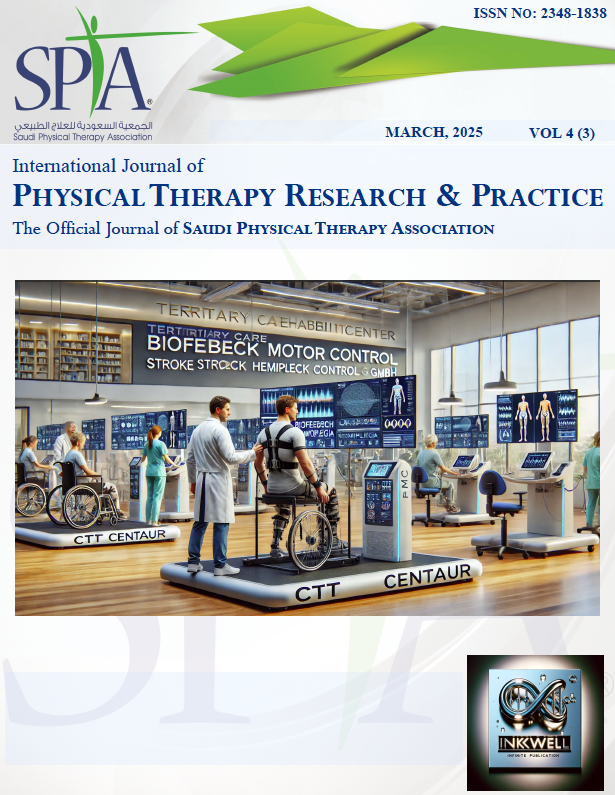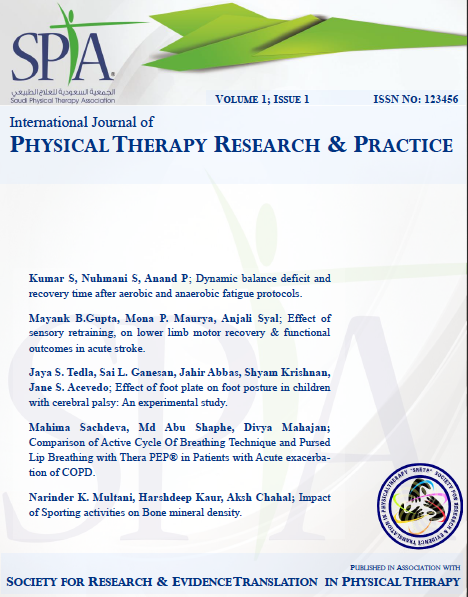Effectiveness of Kinesio Taping Compared to Other Interventions in Children and Adolescents with Idiopathic Scoliosis: A Systematic Review and Meta-Analysis
DOI:
https://doi.org/10.62464/ijoprp.v4i3.96Keywords:
Idiopathic scoliosis, Kinesio taping, Pain, cobb angle, Back muscle enduranceAbstract
Background: Kinesio taping (KT) is used to treat people with scoliosis. However, there is limited evidence to to clarify its mechanism and effectiveness in treating idiopathic scoliosis in children and adolescents. Therefore, this study aimed to evaluate the effectiveness of KT for idiopathic scoliosis in children and adolescents. Methods: The search was conducted in the following databases from inception to November 2022: Scopus, Cochrane Library, Cumulative Index of Nursing and Allied Health Literature, Web of Science, and PubMed. The methodological quality of the included RCTs was assessed for subjects diagnosed with idiopathic scoliosis in children and adolescents. Primary outcomes included pain intensity, Cobb angle, and back muscle endurance. Meta-analysis was conducted to pool the results using standardised mean difference (SMD). Results: Four RCTs (160 participants) were included. The effect of KT with exercises group had better improvement on Cobb angle than other exercise only (SMD = -0.49, 95% confidence interval (CI) -0.89° to -0.09°; p = 0.02; I2 = 25%); but there was no difference between groups on back muscle endurance (SMD = 0.63, 95% CI -0.50 to 1.39 seconds; p = 0.36; I2 = 65%). Data on pain outcomes were insufficient for meta-analysis due to heterogeneity in reporting methods However, two studies showed that KT combined with exercises effectively minimised pain for patients with scoliosis. Conclusion: This systematic review and meta-analysis suggest that adding KT to other interventions improves the Cobb angle and may reduce pain in patients with idiopathic scoliosis. However, due to the limited number of included studies and participants, further high-quality RCTs are needed to confirm these findings.
References
Álvarez-Álvarez, S., San José, F., Rodríguez-Fernández, A. L., Güeita-Rodríguez, J., & Waller, B. J. (2014). Effects of Kinesio® Tape in low back muscle fatigue: Randomized, controlled, double-blinded clinical trial on healthy subjects. Journal of Back and Musculoskeletal Rehabilitation, 27(2), 203–212.
Alves de Araújo, M. E., Bezerra da Silva, E., Bragade Mello, D., Cader, S. A., Shiguemi Inoue Salgado, A., & Dantas, E. H. M. (2012). The effectiveness of the Pilates method: Reducing the degree of non-structural scoliosis, and improving flexibility and pain in female college students. Journal of Bodywork and Movement Therapies, 16(2), 191–198.
Azab, A. R., Elnaggar, R. K., Diab, R. H., & Moawd, S. A. (2020). Therapeutic value of kinesio taping in reducing lower back pain and improving back muscle endurance in adolescents with hemophilia. Journal of Musculoskeletal & Neuronal Interactions, 20(2), 256–263.
Bac, A., Stagraczyński, Ł., Ciszek, E., Górkiewicz, M., & Szczygieł, A. (2009). Efficacy of Kinesiology Taping in the rehabilitation of children with low–angle scoliosis. Fizjo Polska, 9(3), 202–210.
Balne, N. K., Jabeen, S. A., & Mathukumalli, N. (2021). Efficacy of physiotherapy on spinal mobility parameters and pain in persons with adolescent and adult idiopathic structural scoliosis. Indian Journal of Physiotherapy & Occupational Therapy, 15(4), 179–187.
Bassett, K. T., Lingman, S. A., & Ellis, R. F. (2009). The use and treatment efficacy of kinaesthetic taping for musculoskeletal conditions: A systematic review. New Zealand Journal of Physiotherapy, 37(1), 4–11.
Bischoff, L., Babisch, C., Babisch, J., Layher, F., Sander, K., Matziolis, G., et al. (2018). Effects on proprioception by Kinesio taping of the knee after anterior cruciate ligament rupture. European Journal of Orthopaedic Surgery & Traumatology, 28(6), 1157–1164.
Borzì, F., Szychlinska, M. A., Di Rosa, M., & Musumeci, G. (2018). A short overview of the effects of kinesio taping for postural spine curvature disorders. Journal of Functional Morphology and Kinesiology, 3(4), 58.
Castro-Sánchez, A. M., Lara-Palomo, I. C., Matarán-Peñarrocha, G. A., Fernández-Sánchez, M., Sánchez-Labraca, N., & Arroyo-Morales, M. (2012). Kinesio taping reduces disability and pain slightly in chronic non-specific low back pain: A randomised trial. Journal of Physiotherapy, 58(2), 89–95.
Chang, N. J., Chou, W., Hsiao, P. C., Chang, W. D., & Lo, Y. M. (2018). Acute effects of kinesio taping on pain, disability and back extensor muscle endurance in patients with low back pain caused by magnetic resonance imaging–confirmed lumbar disc degeneration. Journal of Back and Musculoskeletal Rehabilitation, 31(1), 85–93.
Choi, T. S., Choi, W. S., & Choi, J. H. (2019). Effects of kinesio-taping and strengthening exercise on Cobb angle and muscle tone in patients with idiopathic scoliosis. Research Journal of Pharmacy and Technology, 12(9), 4438–4442.
Choudhry, M. N., & Ahwas smalla, R. (2016). Adolescent idiopathic scoliosis. Open Orthopaedics Journal, 10, 143–154.
Dalton, J. E., Bolen, S. D., & Mascha, E. J. (2016). Publication bias: The elephant in the review. Anesthesia & Analgesia, 123(4), 812–813.
Dimitrijević, V., Viduka, D., Šćepanović, T., Maksimović, N., Giustino, V., Bianco, A., et al. (2022). Effects of Schroth method and core stabilization exercises on idiopathic scoliosis: A systematic review and meta-analysis. European Spine Journal, 31(12), 3500–3511.
Duangkeaw, R., Laddawong, T., Numchai, R., & Burawan, P. (2019). Effects of three-dimension Schroth exercises and kinesio taping on general mobility of vertebrae, angle of trunk rotation, muscle strength and endurance of trunk, and inspiratory and expiratory muscle strength in children with idiopathic scoliosis. Walailak Journal of Science and Technology, 16(12), 965–973.
El-Nassag, B., Abdul-Rahman, R., Kamel, M. I., El Sayed Elawh Moubarak, E., El-Nassag, B. A., Abd El-Moneim Abd El-Hakim, A., et al. (n.d.). Effects of core stabilization exercise and kinesio taping on pain, Cobb angle and endurance of trunk muscles in children and adolescents with idiopathic scoliosis. Retrieved from https://www.researchgate.net/publication/359994866
Gür, G., Ayhan, C., & Yakut, Y. (2017). The effectiveness of core stabilization exercise in adolescent idiopathic scoliosis: A randomized controlled trial. Prosthetics and Orthotics International, 41(3), 303–310.
Hicks, C. M. (2009). Research methods for clinical therapists: Applied project design and analysis. Elsevier Health Sciences.
Hides, J., Wilson, S., Stanton, W., McMahon, S., Keto, H., McMahon, K., et al. (2006). An MRI investigation into the function of the transversus abdominis muscle during “drawing-in” of the abdominal wall. Spine, 31(6), E175–E178.
Hwang-Bo, G., & Lee, J. H. (2011). Effects of kinesio taping in a physical therapist with acute low back pain due to patient handling: A case report. International Journal of Occupational Medicine and Environmental Health, 24(3), 320–323.
Jada, A., Mackel, C. E., Hwang, S. W., Samdani, A. F., Stephen, J. H., Bennett, J. T., et al. (2017). Evaluation and management of adolescent idiopathic scoliosis: A review. Neurosurgical Focus, 43(4), E2.
Kim, D. J., Choi, I. R., & Lee, J. H. (2020). Effect of balance taping on trunk stabilizer muscles for back extensor muscle endurance: A randomized controlled study. Journal of Musculoskeletal & Neuronal Interactions, 20(4), 541–548.
Konieczny, M. R., Senyurt, H., & Krauspe, R. (2013). Epidemiology of adolescent idiopathic scoliosis. Journal of Child Orthopaedics, 7(1), 3–9.
Lee, J. H., & Yoo, W. G. (2012). Application of posterior pelvic tilt taping for the treatment of chronic low back pain with sacroiliac joint dysfunction and increased sacral horizontal angle. Physical Therapy in Sport, 13(4), 279–285.
Liberati, A., Altman, D. G., Tetzlaff, J., Mulrow, C., Gøtzsche, P. C., Ioannidis, J. P. A., et al. (2009). The PRISMA statement for reporting systematic reviews and meta-analyses of studies that evaluate health care interventions: Explanation and elaboration. PLoS Medicine, 6(7), e1000100.
Liu, D., Yang, Y., Yu, X., Yang, J., Xuan, X., Yang, J., et al. (2020). Effects of specific exercise therapy on adolescent patients with idiopathic scoliosis: A prospective controlled cohort study. Spine, 45(15), 1039–1046.
Maher, C. G., Sherrington, C., Herbert, R. D., Moseley, A. M., & Elkins, M. (2003). Reliability of the PEDro scale for rating quality of randomized controlled trials. Physical Therapy, 83(8), 713–721.
Mohamed, E. A., Rafat Elazab, D., & Hamed, H. M. (2016). Effect of therapeutic exercises augmented by kinesio tape in treatment of scoliosis in adolescent females. International Journal of Medical Research & Health Sciences, 5, 326–332. Retrieved from http://www.ijmrhs.com
Monticone, M., Ambrosini, E., Cazzaniga, D., Rocca, B., & Ferrante, S. (2014). Active self-correction and task-oriented exercises reduce spinal deformity and improve quality of life in subjects with mild adolescent idiopathic scoliosis: Results of a randomised controlled trial. European Spine Journal, 23(6), 1204–1214.
Negrini, S., Donzelli, S., Aulisa, A. G., Czaprowski, D., Schreiber, S., de Mauroy, J. C., Diers, H., Grivas, T. B., Knott, P., Kotwicki, T., & Lebel, A. (2018). 2016 SOSORT guidelines: Orthopaedic and rehabilitation treatment of idiopathic scoliosis during growth. Scoliosis and Spinal Disorders, 13(1), 1–48.
Özkan, F. Ü., Boy, F. N., Kılıç, S. E., Külcü, D. G., Özdemir, G. B., Hartevioğlu, H. Ç., Akpınar, P., & Aktaş, İ. (2020). Clinical and radiological outcomes of kinesiotaping in patients with chronic neck pain: A double-blinded, randomized, placebo-controlled study. Turkish Journal of Physical Medicine and Rehabilitation, 66(4), 459–466.
Page, M. J., McKenzie, J. E., Bossuyt, P. M., Boutron, I., Hoffmann, T. C., Mulrow, C. D., et al. (2021). The PRISMA 2020 statement: An updated guideline for reporting systematic reviews. International Journal of Surgery, 88, 105906.
Sarcevic, Z. (2010). Scoliosis: Muscle imbalance and treatment. British Journal of Sports Medicine, 44(Suppl_1), i16.
Schiller, J. R., & Eberson, C. P. (2008). Spinal deformity and athletics. Sports Medicine and Arthroscopy Review, 16(1), 26–31.
Tacconelli, E. (2010). Systematic reviews: CRD’s guidance for undertaking reviews in health care. The Lancet Infectious Diseases, 10(4), 226.
Tsai, C. T., Chang, W. D., & Lee, J. P. (2010). Effects of short-term treatment with kinesiotaping for plantar fasciitis. Journal of Musculoskeletal Pain, 18(1), 71–80.
Vercelli, S., Colombo, C., Tolosa, F., Moriondo, A., Bravini, E., Ferriero, G., et al. (2017). The effects of kinesio taping on the color intensity of superficial skin hematomas: A pilot study. Physical Therapy in Sport, 23, 156–161.
Weinstein, S. L., & Dolan, L. A. (2015). The evidence base for the prognosis and treatment of adolescent idiopathic scoliosis: The 2015 Orthopaedic Research and Education Foundation Clinical Research Award. The Journal of Bone and Joint Surgery. American Volume, 97(22), 1899–1903.
Weinstein, S. L., Dolan, L. A., Cheng, J. C. Y., Danielsson, A., & Morcuende, J. A. (2008). Adolescent idiopathic scoliosis. The Lancet, 371(9623), 1527–1537.
Yeung, S. S., Yeung, E. W., Sakunkaruna, Y., Mingsoongnern, S., Hung, W. Y., Fan, Y. L., et al. (2015). Acute effects of kinesio taping on knee extensor peak torque and electromyographic activity after exhaustive isometric knee extension in healthy young adults. Clinical Journal of Sport Medicine, 25(3), 284–290.
Yoon, S., & Rhee, M. H. (2016). Effect of physical therapy scoliosis specific exercises using breathing pattern on adolescent idiopathic scoliosis. Journal of Physical Therapy Science, 28(11), 3261–3263.
Zakaria, A., Hafez, A. R., Buragadda, S., & Rao Melam, G. (2012). Stretching versus mechanical traction of the spine in treatment of idiopathic scoliosis. Journal of Physical Therapy Science, 24(11), 1127–1131.

Downloads
Published
Issue
Section
License
Copyright (c) 2025 International Journal of Physical Therapy Research & Practice

This work is licensed under a Creative Commons Attribution-NonCommercial-NoDerivatives 4.0 International License.




